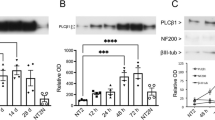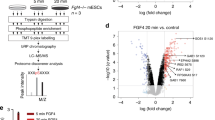Abstract
Extracellular signal-regulated kinase (ERK) controls fundamental cellular functions, including cell fate decisions1,2. In PC12, cells shifting ERK activation from transient to sustained induces neuronal differentiation3. As ERK associates with both regulators and effectors4, we hypothesized that the mechanisms underlying the switch could be revealed by assessing the dynamic changes in ERK-interacting proteins that specifically occur under differentiation conditions. Using quantitative proteomics, we identified 284 ERK-interacting proteins. Upon induction of differentiation, 60 proteins changed their binding to ERK, including many proteins that were not known to participate in differentiation. We functionally characterized a subset, showing that they regulate the pathway at several levels and by different mechanisms, including signal duration, ERK localization, feedback, crosstalk with the Akt pathway and differential interaction and phosphorylation of transcription factors. Integrating these data with a mathematical model confirmed that ERK dynamics and differentiation are regulated by distributed control mechanisms rather than by a single master switch.
This is a preview of subscription content, access via your institution
Access options
Subscribe to this journal
Receive 12 print issues and online access
$209.00 per year
only $17.42 per issue
Buy this article
- Purchase on SpringerLink
- Instant access to full article PDF
Prices may be subject to local taxes which are calculated during checkout





Similar content being viewed by others
Change history
18 February 2022
A Correction to this paper has been published: https://doi.org/10.1038/s41556-022-00867-2
References
Shaul, Y. D. & Seger, R. The MEK/ERK cascade: from signaling specificity to diverse functions. Biochim. Biophys. Acta 1773, 1213–1226 (2007).
Galabova-Kovacs, G. et al. ERK and beyond: insights from B-Raf and Raf-1 conditional knockouts. Cell Cycle 5, 1514–1518 (2006).
Marshall, C. J. Specificity of receptor tyrosine kinase signaling: transient versus sustained extracellular signal-regulated kinase activation. Cell 80, 179–185 (1995).
Yoon, S. & Seger, R. The extracellular signal-regulated kinase: multiple substrates regulate diverse cellular functions. Growth Factors 24, 21–44 (2006).
Leicht, D. T. et al. Raf kinases: function, regulation and role in human cancer. Biochim. Biophys. Acta 1773, 1196–1212 (2007).
Clark-Lewis, I., Sanghera, J. S. & Pelech, S. L. Definition of a consensus sequence for peptide substrate recognition by p44mpk, the meiosis-activated myelin basic protein kinase. J. Biol. Chem. 266, 15180–15184 (1991).
Akella, R., Moon, T. M. & Goldsmith, E. J. Unique MAP Kinase binding sites. Biochim. Biophys. Acta 1784, 48–55 (2008).
Sasagawa, S., Ozaki, Y., Fujita, K. & Kuroda, S. Prediction and validation of the distinct dynamics of transient and sustained ERK activation. Nature Cell Biol. 7, 365–373 (2005).
Santos, S. D., Verveer, P. J. & Bastiaens, P. I. Growth factor-induced MAPK network topology shapes Erk response determining PC-12 cell fate. Nature Cell Biol. 9, 324–330 (2007).
Niihori, T. et al. Germline KRAS and BRAF mutations in cardio-facio-cutaneous syndrome. Nature Genet. 38, 294–296 (2006).
Harrisingh, M. C. & Lloyd, A. C. Ras/Raf/ERK signalling and NF1. Cell Cycle 3, 1255–1258 (2004).
Ahmadian, M. R., Hoffmann, U., Goody, R. S. & Wittinghofer, A. Individual rate constants for the interaction of Ras proteins with GTPase-activating proteins determined by fluorescence spectroscopy. Biochemistry 36, 4535–4541 (1997).
York, R. D. et al. Rap1 mediates sustained MAP kinase activation induced by nerve growth factor. Nature 392, 622–626 (1998).
Formstecher, E. et al. PEA-15 mediates cytoplasmic sequestration of ERK MAP kinase. Dev. Cell 1, 239–250 (2001).
Traverse, S., Gomez, N., Paterson, H., Marshall, C. & Cohen, P. Sustained activation of the mitogen-activated protein (MAP) kinase cascade may be required for differentiation of PC12 cells. Comparison of the effects of nerve growth factor and epidermal growth factor. Biochem. J. 288 (Pt 2), 351–355 (1992).
Krueger, J., Chou, F. L., Glading, A., Schaefer, E. & Ginsberg, M. H. Phosphorylation of phosphoprotein enriched in astrocytes (PEA-15) regulates extracellular signal-regulated kinase-dependent transcription and cell proliferation. Mol. Biol. Cell 16, 3552–3561 (2005).
Trencia, A. et al. Protein kinase B/Akt binds and phosphorylates PED/PEA-15, stabilizing its antiapoptotic action. Mol. Cell Biol. 23, 4511–4521 (2003).
Araujo, H., Danziger, N., Cordier, J., Glowinski, J. & Chneiweiss, H. Characterization of PEA-15, a major substrate for protein kinase C in astrocytes. J. Biol. Chem. 268, 5911–5920 (1993).
Le Gallic, L., Virgilio, L., Cohen, P., Biteau, B. & Mavrothalassitis, G. ERF nuclear shuttling, a continuous monitor of Erk activity that links it to cell cycle progression. Mol. Cell Biol. 24, 1206–1218 (2004).
Ando, R., Mizuno, H. & Miyawaki, A. Regulated fast nucleocytoplasmic shuttling observed by reversible protein highlighting. Science 306, 1370–1373 (2004).
Volmat, V., Camps, M., Arkinstall, S., Pouyssegur, J. & Lenormand, P. The nucleus, a site for signal termination by sequestration and inactivation of p42/p44 MAP kinases. J. Cell Sci. 114, 3433–3443 (2001).
Malik, T. H. et al. Transcriptional repression and developmental functions of the atypical vertebrate GATA protein TRPS1. EMBO J. 20, 1715–1725 (2001).
Cantor, A. B. GATA transcription factors in hematologic disease. Int. J. Hematol. 81, 378–384 (2005).
Brewer, A. & Pizzey, J. GATA factors in vertebrate heart development and disease. Expert Rev. Mol. Med. 8, 1–20 (2006).
Kaiser, F. J. et al. Novel missense mutations in the TRPS1 transcription factor define the nuclear localization signal. Eur. J. Hum. Genet. 12, 121–126 (2004).
Kobayashi, H. et al. Missense mutation of TRPS1 in a family of tricho-rhino-phalangeal syndrome type III. Am. J. Med. Genet. 107, 26–29 (2002).
Rodriguez-Viciana, P. et al. Germline mutations in genes within the MAPK pathway cause cardio-facio-cutaneous syndrome. Science 311, 1287–1290 (2006).
Kholodenko, B. N. Cell-signalling dynamics in time and space. Nature Rev. Mol. Cell Biol. 7, 165–176 (2006).
George, A. J., Stark, J. & Chan, C. Understanding specificity and sensitivity of T-cell recognition. Trends Immunol. 26, 653–659 (2005).
Trinkle-Mulcahy, L. et al. Identifying specific protein interaction partners using quantitative mass spectrometry and bead proteomes. J. Cell Biol. 183, 223–239 (2008).
de Rooij, J. & Bos, J. L. Minimal Ras-binding domain of Raf1 can be used as an activation-specific probe for Ras. Oncogene 14, 623–625 (1997).
Obenauer, J. C., Cantley, L. C. & Yaffe, M. B. Scansite 2.0: Proteome-wide prediction of cell signaling interactions using short sequence motifs. Nucleic Acids Res. 31, 3635–3641 (2003).
Acknowledgements
We thank P. Mortensen for help with MSQuant, A. Pitt and C. Ward for help with MS, O.Rath for the design of primers and G. Cesareni and A. Chatraryamontri for help with submission of the interaction data to the IMEx consortium through MINT. The work was supported by the European Union Interaction Proteome project (LSHG-CT-2003-505520), the RASOR project (BBSRC and EPSRC) and Cancer Research UK.
Author information
Authors and Affiliations
Contributions
A.v.K. performed most of the experiments, analysed the data and wrote the paper; D.B. performed the PEA-15 experiments; M.B., R.O. and D.G. generated the mathematical model; D.S., W.B., A.v.K., N.M., K.Y., and A.L. generated and analysed MS data; G.K. performed bioinformatic analysis; W.K. conceived the study and edited the paper.
Corresponding author
Ethics declarations
Competing interests
The authors declare no competing financial interests.
Supplementary information
Supplementary Information
Supplementary Information (PDF 2214 kb)
Supplementary Information
Supplementary Table 1 (XLS 28 kb)
Supplementary Information
Supplementary Table 2 (XLS 199 kb)
Supplementary Information
Supplementary Table 3 (XLS 16 kb)
Supplementary Information
Supplementary Table 4 (XLS 68 kb)
Supplementary Information
Supplementary Table 5 (XLS 33 kb)
Supplementary Information
Supplementary Table 6 (XLS 28 kb)
Supplementary Information
Supplementary Table 7 (XLS 10 kb)
Supplementary Information
Supplementary Table 8 (XLS 29 kb)
Supplementary Information
Supplementary Table 9 (XLS 45 kb)
Rights and permissions
About this article
Cite this article
von Kriegsheim, A., Baiocchi, D., Birtwistle, M. et al. Cell fate decisions are specified by the dynamic ERK interactome. Nat Cell Biol 11, 1458–1464 (2009). https://doi.org/10.1038/ncb1994
Received:
Accepted:
Published:
Issue Date:
DOI: https://doi.org/10.1038/ncb1994



